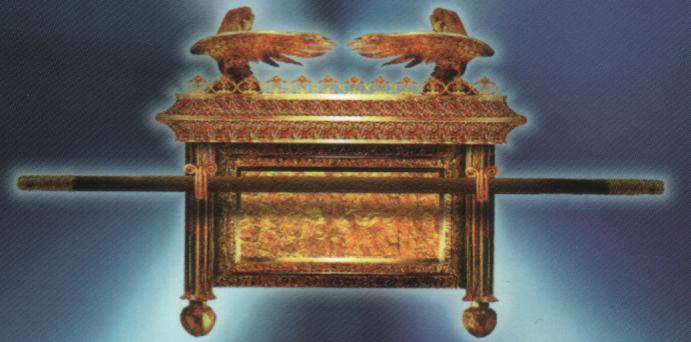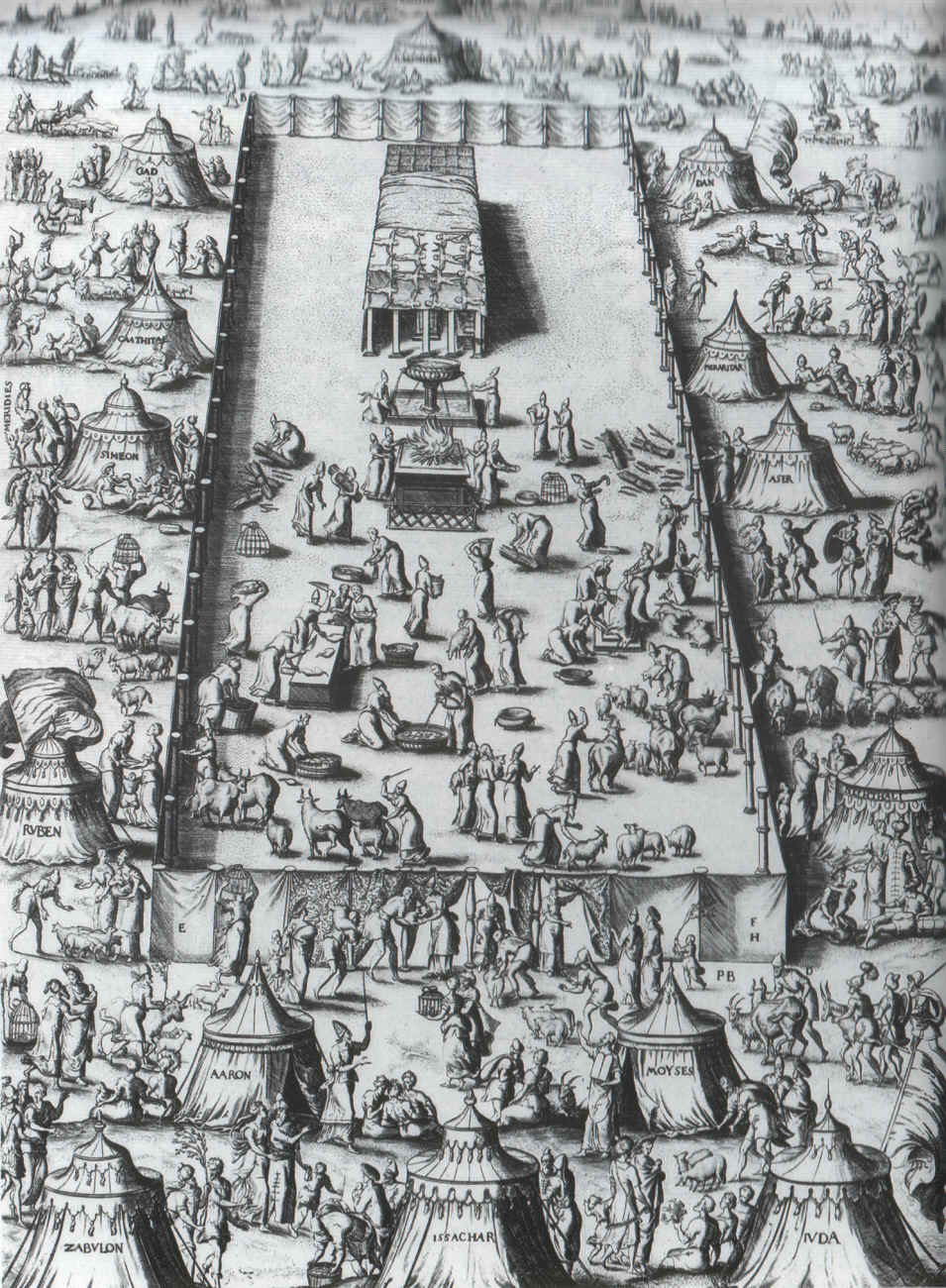
|
|
PART 1 |
| History of the Ark |
|
- In our own attempt to follow the history of the Ark, we shall look at ancient sources from which the biblical narrative seems to have been drawn.
The Bible describes how the Ark led the people of Israel into The Promised Land, and how David found it after years of neglect and brought it to Jerusalem.
When Solomon built a temple for it, it became part of a royal cult in which the House of David ruled as
anointed kings in the holy city, but were denounced by the prophets for their belief that it guaranteed the presence of God.
As the armies of Babylon destroyed the Temple, the Ark seems to have disappeared, leaving the following generations to wonder if it had been captured , or destroyed , or carried to safety .
Arab historians even reported that it was brought to Arabia and sacred stones that mark the covenant between God and
man are still venerated in Mecca.
This is not only a report for what happened to the Ark , but a search for what can be believed about it .
With the Ark , the truth seems to lie precisely in ambiguity. The Ark crosses the boundary between myth and history, the desert and the city, Israel and Canaan, life and death , heaven and earth.
Most of us are familiar with the Bible and the part which happened on the third new moon after Israelites escape from slavery:
"You have seen what I did to the Egyptians , and how I brought you to myself on the wings of eagles. Now therefore, if you obey my voice and keep my covenant, you will be my own
possession among all peoples for all the earth is mine. You will be to me a kingdom of priests, a holy nation."
When Moses repeated these words to the Israelites , they agreed that they would obey whatever commandments God might have for them. And one of the instructions from God was how the people of Israel were to construct an extraordinary object : a box or chest, which we know in English as an "ARK", after the Latin arca .
|
| Ark and it's Power |
|
-

-
The Ark of The Covenant was not the only thing that God told Moses to build. He provided further instructions, in no less detail, for a tent and all the furnishings that would accompany the tent.
When the Ark was ready, Moses put the Tablets of The Law inside it. Placing the poles in the rings and the cover on top, he brought the Ark into the tent that God had told the people of Israel to make.
After all the instructions had been obeyed, a cloud covered the tent and the glory of the Lord filled it.
This is the account of the creation of The Ark of The Covenant that most Jews or Christians would
recognize.
IT WAS A BOX CONTAINING THE TABLETS ON WHICH THE HAND OF GOD HAD WRITTEN THE TEN COMMANDMENTS , AND IT LED THE PEOPLE OF ISRAEL INTO THE PROMISED LAND.
-
This is the Ark that Joshua carried seven times around the walls of Jericho, which brought them tumbling down...The power ascribed to this object, which could cause the walls of a city to collapse and afflict it's enemies with disease, was immense.
IT BROUGHT DEATH TO ANYONE WHO TOUCHED IT OUTSIDE THE RITUAL REVEALED TO MOSES!
Although it was hidden from anyone except the high priest:
EVEN THE HIGH PRIEST COULD ONLY APPROACH IT ON ONE DAY OF THE YEAR, AND ONLY IF HE BLINDED HIMSELF WITH A CLOUD OF INCENSE TO PROTECT HIMSELF FROM ITS POWER.
After centuries in which ALMOST no one saw it, the Ark seems to have vanished in circumstances about which the Hebrew Bible has almost nothing to say, either before or during the destruction of the Temple by the armies of Babylon. The Temple was built
again but an Ark it seems was never placed within the inner sanctuary.
One of the earliest attempts to explain the Ark , which has survived outside the Bible itself, was written in the first century A.D. by the Jewish philosopher Philo, whose primary concern was not with it's fate, but with how it could still be used as a key to mystical enlightenment.
But, we can go back now, reading the Book of Exodus, where the skilled
craftsman BEZALEL constructs the Ark. He is a man, we are told, who is filled:
" with the Spirit of God, with ability and intelligence, with knowledge and all craftsmanship, to devise artistic designs, to work in gold,
silver and bronze, in cutting stones for setting, and in carving wood, for work in EVERY CRAFT. "
With a team of assistants beside him, THE ARK HE CONSTRUCTS IS ELABORATE, covered in gold, decorated with a moulding of gold around it and equipped with cast gold rings so that it can be carried.
In Deuteronomy, however, MOSES HIMSELF MAKES A SIMPLE ARK OF ACACIA WOOD. THERE IS NO REFERENCE TO GOLD or to a decorative
moulding , AND THERE IS NO MENTION OF AN ELABORATE COVER WITH THE FIGURES OF TWO WINGED CHERUBIM. WHICH OF THESE IS THE CORRECT DESCRIPTION ?
Why would both be included? Could they both be accurate?
|
| Tabernacle and the Ark |
|
-

- In 1712 , Herman Witsius remarked that, even though God had created the entire universe in six days , he needed forty to instruct Moses about the Tabernacle. The Bible could describe the structure of the world in a single chapter , but the Tabernacle required six .
Witsius was not joking. For a modern reader, the account of the Tabernacle is perhaps the most perplexing of all passages in the Hebrew Bible. Even if the Ark of the Covenant were placed in its innermost chamber, it is not always easy to understand why the details of how to build a very complicated tent should be a matter of spiritual significance.
According to the descriptions in Exodus , THE TABERNACLE IS CONSTRUCTED AS A HEAVY FRAME OF ACACIA WOOD, COVERED BY SEVERAL TYPES OF CURTAIN MADE OF DIFFERENT
FIBERS AND WOVEN IN DIFFERENT TECHNIQUES, AND THEN BY A TENT OF GOAT WOOL. The authors do not present the construction of the Tabernacle as a miraculous event. The craftsmen may be inspired by the Spirit of God , but God does not send the materials down from heaven. The tribes simply gather up their possessions so that sufficient
amounts of acacia wood, embroidered fabric and precious metal can be applied to the task.
According to the Priestly Code, the Ark was always covered. It was kept in darkness, in the inner sanctuary of the TABERNACLE. NO ONE COULD TOUCH IT OR SEE IT, AND ANYONE WHO DID WOULD DIE. Even the priest had special instructions when he performed the annual sacrifice on the Day of Atonement:
"AND HE SHALL TAKE A SENSOR FULL OF COALS OF FIRE FROM THE ALTAR BEFORE THE LORD , AND TWO HANDFULS OF SWEET INCENSE BEATEN SMALL ; AND HE SHALL BRING IT WITHIN THE VEIL AND PUT INCENSE ON THE FIRE BEFORE THE LORD , THAT THE CLOUD OF INCENSE MAY COVER THE MERCY SEAT WHICH IS UPON THE TESTIMONY , LEST HE DIE."
When the Ark was moved, great care was taken to avoid anyone approaching it or seeing it. Precise regulations described how Aaron and his sons were to enter the Tabernacle and take down the veil of the screen and cover the Ark with it. They would then place a covering of goatskin over it, and spread a cloth of blue over the goatskin. Only then could the Levites move it.
The Ark and the Tabernacle are separated when the sons of Eli take the Ark into battle against the Philistines and it is captured. Even though the Ark is recovered and placed in the house of ABINADAB at Gibeah, the Tabernacle remains at Shiloh. The fate of Shiloh is NEVER mentioned in the historical books, and although the prophet Jeremiah refers to it's destruction on three occasions, he never speaks of the Tabernacle.
According to the First Book Of Chronicles, the Tabernacle was located at the "high place" of Gideon. In the accounts provided by the Chronicles and by I Kings, when Solomon dedicated the Temple in Jerusalem, the priests and the Levites "brought up the Ark of The Lord, the Tent of Meeting, and ALL the holy vessels that were in the Tent."
After the repairs to the Temple and the renewal of worship by the Judean
king Hezekiah in the VIII century BC , there is NO FURTHER MENTION OF THE TABERNACLE IN THE HISTORICAL BOOKS.
In Psalm 74, a single verse...
"They set your sanctuary on fire to the ground they desecrated
the tabernacle of your name"
- would suggest that the Tabernacle had been burnt when the Babylonians destroyed the Temple, if the phrase
"MISHKAN of your name"
were understood as referring to the Tabernacle itself, rather than alluding in a more general way to the Temple as the place where God dwells.
We mentioned earlier that the Ark was for some time in SHILOH. It is not entirely clear where the Ark had been before its arrival at Shiloh.
|
|
|
End of Part I |

![]()
